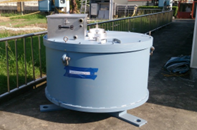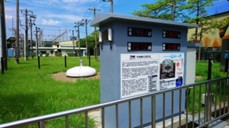Grid Scale ESS
Strategies and plans for the development of a battery energy storage system
As Taiwan moves towards its low-carbon and climate goals, it is actively developing green power and pursuing the installation of an energy storage system (ESS). Upon completion, the system will not only smooth green power generation, but also maintain frequency stability in the power system. In addition to those advantages, the system will increase the capacity value of renewable energy and improve power dispatching.
By 2025, Taiwan will have greatly increased its use of renewable energy. Consequently, TPC is working to add ancillary service capacity to its grid to accommodate the increased renewable energy connections. Moreover, TPC is preparing diverse responsive strategies including the installation of combined cycle generators with quick ramp rates, changing pumping/storage operating modes, and adopting energy storage equipment.
The 2025 target for Taiwan’s Battery Energy Storage System (BESS) is 1000MW. TPC will incorporate 160MW of equipment at its own sites with an additional 840MW of purchased storage capacity. BESS will help smooth the generation intermittency of renewable energy. Following any power system accidents, it will also be able to help withstand the failure of a large generating unit without causing the low-frequency relay action and tripping the user load. The 840MW of purchased energy storage will include 500MW with an energy transfer function, which can help relieve pressure on the system caused by peak loads at night.The status of battery energy storage equipment installation
By the end of 2021, TPC has completed energy storage battery demonstration systems at two sites. These include a system on Kinmen with a total capacity of 3.8MW (11.8MWh) and a second system at the Shulin Branch of the Taiwan Power Research Institute with a total capacity of about 1.25MW (1.9MWh). Additionally, ITRI has completed battery systems at TPC’s Solar PV sites in Yongan (Kaohsiung), Longjing (Taichung) and Changbin (Changhua). These systems have a total capacity of about 6.5MW (6.4MWh).
In 2023, TPC has added 100MW of battery energy storage systems. At present, TPC has about 60MW of battery energy storage systems under construction.
In 2020, TPC purchased 15MW of automatic frequency control (AFC) ancillary services from five private companies. These energy storage battery systems began operation in 2021.
In 2021, the energy trading platform was stablished. Moving forward, the frequency regulation ancillary services for energy storage will be obtained from the Day-Ahead ancillary services market. The platform’s qualified trading capacity was 958.2MW as of April 2024.

Tainan Salt Fields and Luyuan Substation Energy Storage System
In 2022, TPC has finished 20MW ESS in Tainan Salt Fields Solar PV site and 20MW ESS in Luyuan substation. In 2023, TPC has finished 60MW ESS in Longtan substation.
Tainan Salt Fields, the first storage system with renewable energy in Taiwan, had won 2023 Asia Responsible Enterprise Awards in the category of Green Leadership. The storage systems have the advantage of fast charging and discharging, especially matching renewable energy characteristic, and helping solar PV generator electric output more smooth, also maintaining power system frequency and function of energy shift.
Tainan Salt Fields Energy Storage System


Luyuan Substation Energy Storage System


Kinmen Energy Storage System
Kinmen is an islanding power system. As renewable energy penetration increases, a possible way to make the power system more reliable is to install energy storage system (ESS). TPRI has already installed two sets of ESS in Xia-xing Power Plant, which not only assist power system operation but also enhance the knowledge and dispatch experience of ESS.
The power type of ESS uses Li battery(2MW/1MWh), which has already been constructed in December 2009. This system provides power system ancillary services and spinning reserve, carries out functions like renewable energy smoothing, frequency-watt control, voltage-var control and frequency deviation-P control. The energy type of ESS uses NaS battery(1.8MW/10.8MWh), which has already been constructed in December 2020. The main purposes are to execute load transformation, adjusting renewable energy generation period, and increasing diesel engine’s dispatch flexibility.


Green Energy Smart Management System of TPRI Sulin branch
The green energy smart management system installed in the Sulin branch of Taiwan Power Research Institute(tpri-EMS) was designed base on micro-grid concept. The tpri-EMS is consists of 9 energy management subsystems, including the photovoltaic storage test site. About battery energy storage systems, the performance test and verification of all-vanadium redox flow batteries and lithium-ion battery energy storage systems have been completed. In the future, the focus will be on the development of application functions of energy storage systems in microgrids, such as peak shaving, load tracking, automatic demand response, reduction of contract capacity, photovoltaic smoothing, implement of international information and communication standards and the verification of micro-grid transition function tests, including black start and seamless switching.


Evaluation of all-vanadium flow battery in renewable energy storage
In response to the intermittent of renewable energy power generation, energy storage technology is one of the effective solutions. Taiwan Power Research Institute (TPRI) has conducted energy storage demonstration experiments for smoothing renewable energy generation and controlling peak power demand. To successfully achieve these goals, TPRI has introduced an all vanadium redox flow battery’s energy storage system from Sumitomo Electric Industries Ltd. in May 2016. This 125kW/750kWh system was installed at Shulin branch of TPRI in 2017. Battery performance test, demand response, renewable energy smoothing, island mode operation, and cost minimization are tested in this system. In addition, long-term testing of the performance and durability of flow batteries are carried out. As technical comparison, a 250kW/400kWh and a 1.MW/1.5MWh container type lithium-ion battery energy storage system from local company has been constructed in this area in 2019.


Demonstration and experimental study of a flywheel energy storage system for long duration applications
Flywheel Energy Storage System (FESS) stores energy by converting the electricity and the spinning kinetic energy with a bidirectional power conversion device.FESS is suitable for use cases that require hundreds of thousands cycles of charge & discharge. The power output ranges from kW to MW within a short period of 1 second
Mechanical energy of FESS is one of the conventional and stable energy storage mediums. The performance in terms of energy storage density, energy efficiency, power, and response time of the FESS is outstanding. Using mechanical energy for energy storage has advantages of long cycle life, reliable operation and zero impact to the environment. The energy efficiency of the FESS depends on manufacturing materials, electrical machines, types of bearing, and the vacuum chamber housing the rotor. The State of Charge (SOC) of the FESS can be directly calculated by monitoring the rotational speed of the flywheel which effectively improves the reliability of the power management system
In general, most FESSs can provide high power instantaneously with short duration. However, the FESSs providing the long charge and discharge duration for peak shaving and energy shifting is rare. Therefore, a FESS with rated power of 8kW, discharge duration of 4 hours, and 32 kWh energy has been installed by TPRI in TPC in 2019. The FESS is tested for various technical characteristics, and the reliability and corresponding performance of the specification have been demonstrated for the reference of application in the future.
After several earthquakes with magnitude 4 and magnitude 6 on the Richter scale, the flywheel system still works continuously. It also can be operated stably in summer without the use of air conditioning. The manpower and material costs required for operation and maintenance are extremely low, and only the vacuum pump needs to be maintained annually. The flywheel is expected to be worn out after long-term operation, and it only needs to replace the bearing for continuous running. It has great advantages in enduring application and provides reliable and stable backup power.



Related Regulations
To respond to domestic renewable energy development and energy management demand, energy storage equipment, installed by consumers, is a great tool which can be used with demand management and participate in ancillary service, is beneficial to improving power system stability.
To meet the demand of domestic energy storage equipment installation, TPC announced guidelines for grid connection of energy storage system on March 6, 2020.
Related news
- https://www.energy-storage.news/powin-agrees-to-supply-5-8gwh-of-battery-storage-to-developers-for-projects-in-us-and-taiwan/
- https://www.energy-storage.news/powin-energy-supplies-battery-storage-for-microgrid-in-israel-frequency-regulation-in-taiwan/
- https://www.energy-storage.news/roundup-fluences-first-taiwan-project-redflows-2mwh-california-flow-battery-stem-inc-acquires-alsoenergy/
- https://renewablesnow.com/news/nhoa-to-develop-160-mw-of-battery-storage-for-taiwans-tcc-758813/
- https://www.eetasia.com/bureau-veritas-executes-iec-62933-testing-and-certification-for-taiwan-powers-60mw-on-site-energy-storage-system/
- https://renewablesnow.com/news/fluence-teco-to-add-60-mw96-mwh-of-battery-storage-for-taiwans-taipower-782318/
- https://www.energy-storage.news/taiwan-cement-corporation-adds-to-420mwh-bess-order-from-subsidiary-nhoa/
- https://www.digitimes.com/news/a20221221PD209/energy-storage-system-tatung-forever-energy.html
- https://www.altenergymag.com/article/2022/06/2022-top-article-sma-storage-solution-turns-the-lights-back-on-in-taiwan/37369
- https://www.smart-energy.com/regional-news/asia/enel-x-deploys-world-first-battery-swapping-vpp-in-taiwan/
- https://www.energy-storage.news/nhoa-parent-company-tcc-raising-funds-for-energy-storage-players-10x-growth-masterplan/